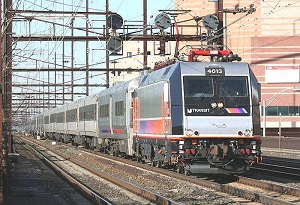Happening Now
Hopping the Local: Pressing the Case (Part 3)
August 15, 2012
Written By Malcolm Kenton
The third and final installment (for now) of our periodic round-up of goings on in local-level passenger train advocacy:

The New Jersey Association of Railroad Passengers’ Newsletter Report (June 26) has a travelogue from one of the first revenue runs of New Jersey Transit’s new dual-mode locomotives, which can operate either on diesel fuel or on electricity from overhead wires. They are ideal for three NJT lines that are only part-electrified, and should result in a significantly shorter commute for riders whose trips traverse both electrified and non-electrified segments. NJ-ARP’s Phil Craig reports that his train dwelled at a station for 5 minutes while the crew changed the power mode, a time that should be further reduced as crews gain more experience with the dual-mode locomotives.
At the California High-Speed Rail Blog, Robert Cruickshank says longstanding San Francisco-San Jose commuter line Caltrain’s remarkable ridership growth, particularly on the skip-stop Baby Bullet trains, should present a solid rebuttal to high-speed rail opponents on the Peninsula, as more residents are voting with their feet by riding faster trains than are speaking out against them. Cruickshank also calls the anti-high-speed rail, but pro-Amtrak, position of Kings County leaders “bizarre,” and says there’s no reason why the county can’t have both a stop on the soon-to-be-built high-speed line as well as more frequent Amtrak San Joaquin service with multiple stops in the county.
The Association of Oregon Rail and Transit Advocates (AORTA) wrote a letter in opposition to a proposed reconstruction of Interstate 5 through downtown Portland and across the Columbia River, saying it will create huge disruptions to daily life and will provide little benefit. No viable public transportation alternative to this project has yet been proposed—greater Portland’s light-rail system is east-west oriented, with no effective north-south corridor. “The message here flies in the face of agency environmental values, raising the idea that freeways are more important than public transport, a clear double standard,” AORTA says.
"The National Association of Railroad Passengers has done yeoman work over the years and in fact if it weren’t for NARP, I'd be surprised if Amtrak were still in possession of as a large a network as they have. So they've done good work, they're very good on the factual case."
Robert Gallamore, Director of Transportation Center at Northwestern University and former Federal Railroad Administration official, Director of Transportation Center at Northwestern University
November 17, 2005, on The Leonard Lopate Show (with guest host Chris Bannon), WNYC New York.
Comments